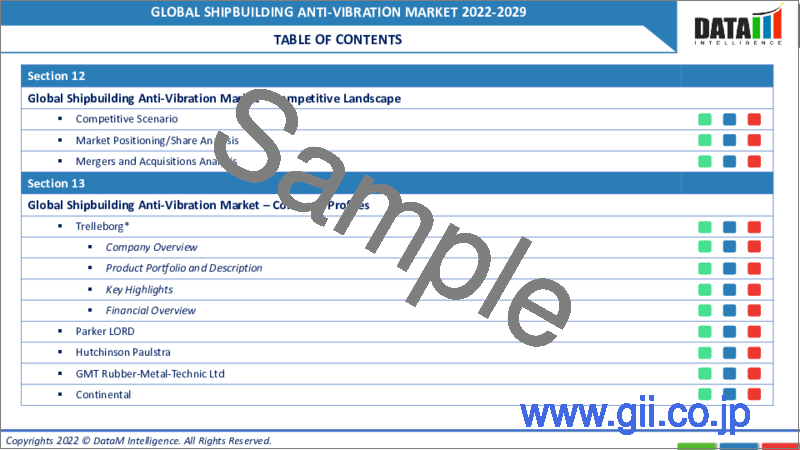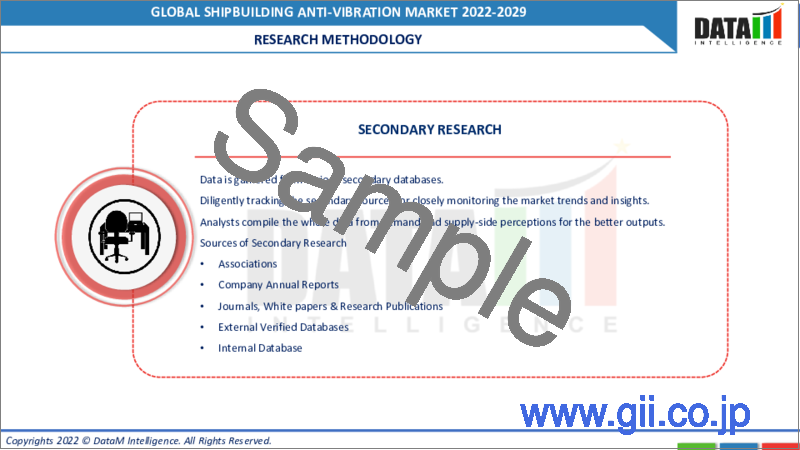|
|
市場調査レポート
商品コード
1129217
造船用防振の世界市場-2022-2029Global Shipbuilding Anti-Vibration Market - 2022-2029 |
||||||
|
● お客様のご希望に応じて、既存データの加工や未掲載情報(例:国別セグメント)の追加などの対応が可能です。 詳細はお問い合わせください。 |
|||||||
| 造船用防振の世界市場-2022-2029 |
|
出版日: 2022年09月29日
発行: DataM Intelligence
ページ情報: 英文 198 Pages
納期: 約2営業日
|
- 全表示
- 概要
- 目次
市場力学
消費者支出の増加と豪華なライフスタイルへの嗜好の高まりが、世界の造船用防振材市場の主要な市場促進要因となっています。しかし、法外なメンテナンスコストや交換コストが市場の主な抑制要因となっています。
消費者支出の増加、豪華なライフスタイルへの嗜好の高まり
観光産業の成長と贅沢な生活への嗜好の高まりが、客船市場の成長を促し、造船防振市場を加速させると予想されます。セーリングによるバケーション活動に対する消費者の関心は高まっており、欧州および世界におけるブルーエコノミーの成長の大部分を占めています。セーリング船は、沿岸地域を探索するための低負荷でより現実的な手段です。さらに、ヨットの利用者のプロファイルは、所有するよりもチャーターボートを好む、若くて経験の浅い消費者にシフトしており、それによってヨット市場を牽引しています。
造船には数多くの防振部品が使用されているため、造船用防振製品の世界市場は、予測期間中にかなりの速度で拡大すると予想されます。快適な船舶に対する高い需要が、造船用防振システムの需要を促進する主要因であり、贅沢なライフスタイルに対する消費者の好みの高まりも相まって、このような市場の拡大が見込まれています。
COVID-19の影響分析
COVID-19は、サプライチェーンの混乱による需要への影響から、世界経済および海運部門にマイナスの影響を与えました。パンデミックは海上輸送やその他の海洋活動を減少させ、造船防振産業を崩壊させた。国際貿易、観光、サプライチェーンなど、すべてが未曾有の規模で影響を受けた。2021年の最初の時期を過ぎると、その影響は薄れ始め、コンテナ輸送と促進要因ルク商品の両方の数量が回復し始めました。パンデミックは経済や分野に大きな混乱をもたらしましたが、eコマース貿易に前向きな傾向が見られるなど、この分野にも新たな機会が生まれました。規制が撤廃されたことで、政府の主導により造船業が活発化しています。
同様に、The Internet of Things(IoT)は、海運業界の設備購入方針において最も大きな変化のひとつとなるでしょう。IoTは、配置環境との相互作用という共通の目標を達成するために、複数の活動で緊密な連携を実現するセンサーやデバイスの集合体です。さらに、ブロックチェーンはもはやデジタル通貨にとどまらず、記録保持が必要なあらゆるものに徐々に浸透しつつあります。責任ある製品調達への懸念が高まる中、海運業界にとって貿易や商取引の新たな地平を切り開くことになるでしょう。記録管理をデジタル化することで、透明性を大幅に向上させることができます。FMCG業界など多くの企業は、自社製品の調達詳細を作成する必要があり、ブロックチェーンベースのスマートコントラクトは、新しいプレイヤーにとって国際取引をより速く、より安全に、より手頃な価格で行うことができるようになります。海運業界における他のいくつかの革新は、市場を後押しし、それによって造船用防振材料と製品の将来の需要を押し上げると思われます。
世界の造船用防振市場レポートでは、約69の表、77の図、ほぼ198ページが提供されることになります。
目次
第1章 造船用防振の世界市場- 調査手法と調査範囲
- 調査手法
- 調査目的および調査範囲
第2章 造船用防振の世界市場-市場の定義と概要
第3章 造船用防振の世界市場- エグゼクティブサマリー
- 製品別市場内訳
- 機能別市場内訳
- 素材別市場内訳
- アプリケーション別市場内訳
- 地域別市場内訳
第4章 造船用防振の世界市場-市場力学
- 市場インパクトファクター
- 促進要因
- 消費者支出の増加、豪華なライフスタイルへの嗜好の高まり
- 阻害要因
- 法外な交換・メンテナンスコスト
- ビジネスチャンス
- 影響分析
- 促進要因
第5章 造船用防振の世界市場-産業分析
- ポーターのファイブフォース分析
- サプライチェーン分析
- 価格設定分析
- 規制分析
第6章 造船用防振の世界市場-COVID-19分析
- COVID-19の市場分析
- COVID-19市場参入前のシナリオ
- COVID-19の現在の市場シナリオ
- COVID-19の後、または将来のシナリオ
- COVID-19の中での価格ダイナミクス
- 需要-供給スペクトラム
- パンデミック時の市場に関連する政府の取り組み
- メーカーの戦略的な取り組み
- まとめ
第7章 造船用防振の世界市場- 製品別
- マウント
- ベアリングパッド
- ベローズ
- ワッシャ
- その他
第8章 造船用防振の世界市場-機能別
- エンジン振動
- HVAC振動
- 発電機・ポンプ
- その他
第9章 造船用防振の世界市場-素材別
- エラストマー
- プラスチック
- その他
第10章 造船用防振の世界市場-用途別
- タグボート
- ヨット
- 漁船
- モーターボート
- 帆船
- 客船
- コンテナ船
- オイルタンカー
- ばら積み貨物船
- その他
第11章 造船用防振の世界市場-地域別
- 北米
- 米国
- カナダ
- メキシコ
- 欧州
- ドイツ
- 英国
- フランス
- イタリア
- ロシア
- その他欧州
- 南米
- ブラジル
- アルゼンチン
- その他の南米地域
- アジア太平洋地域
- 中国
- インド
- 日本
- オーストラリア
- その他アジア太平洋地域
- 中東・アフリカ地域
第12章 造船用防振の世界市場- 競争情勢
- 競合シナリオ
- 市況/シェア分析
- M&A(合併・買収)分析
第13章 造船用防振の世界市場-企業プロファイル
- Trelleborg
- 企業概要
- 製品ポートフォリオと説明
- 主なハイライト
- 財務概要
- Parker LORD
- Hutchinson Paulstra
- GMT Rubber-Metal-Technic Ltd
- Continental
- AMC Mecanocaucho
- Getzner Werkstoffe GmbH
- Vibracoustics Ltd
- Angst+Pfister
- Bridgestone Industrial
第14章 造船用防振の世界市場-重要考察
第15章 造船用防振の世界市場-DataM
Market Overview
The Shipbuilding Anti-Vibration Market reached US$ XX million in 2021 and is expected to record significant growth by reaching up to US$ XX million by 2029, growing at a CAGR of 4.80% during the forecast period (2022-2029).
The shipbuilding industry is growing, innovative and competitive with significant social and economic significance. Shipbuilding anti-vibration products ranging from vibration mounts to more complex tailor-made air suspension deck house solutions reduce the negative effects of vibration and noise on all systems on board, the crew, the environment and the ship itself while ensuring continuous operation.
Market Dynamics
Rising consumer spending and a growing preference for opulent lifestyles are major market drivers for the global shipbuilding anti-vibration market. However, the exorbitant maintenance and replacement costs are a major market restraint.
Rising consumer spending and a growing preference for opulent lifestyles
The growing tourism industry, combined with the growing choice for lavish lives, is expected to drive passenger ship market growth, accelerating the shipbuilding anti-vibration market. Consumer interest in sailing vacation activities is growing, accounting for a significant portion of Blue Economy growth in Europe and globally. Sailing ships are a low-impact and more viable mode of exploring coastal areas. Further, the yachters' profiles shift toward younger and less experienced consumers who prefer charter boats rather than own them, thereby driving the market for yachts.
Because of the assimilation of numerous anti-vibration components in shipbuilding, the global market for shipbuilding anti-vibration products is forecast to expand at a significant rate during the forecast period due to the high demand for comfortable ships is a major factor driving the demand for anti-vibration systems for shipbuilding coupled with the growing consumer preference towards an opulent lifestyle.
COVID-19 Impact Analysis
COVID-19 had a negative impact on the global economy and the shipping sector due to supply chain disruptions that impacted demand. The pandemic reduced maritime transportation and other marine activities, disintegrating the shipbuilding anti-vibration industry. International trade, tourism and the supply chain were all impacted on an unprecedented scale. After the initial time frame of 2021, the impact began to fade and volumes for both containerized trade and dry bulk commodities began to recover. Though the pandemic caused significant disruption to the economy and sector, it also created new opportunities for the sector, with a positive trend in e-commerce trade. With the removal of restrictions, the shipbuilding industry is gaining traction, thanks to government initiatives.
Similarly, The Internet of Things (IoT) will be one of the most significant changes in the maritime industry's equipment purchasing policies. IoT is a collection of sensors and devices that work together to achieve close cooperation on multiple activities to achieve a common goal of interacting with their deployment environment. Further, Blockchain is no longer limited to digital currencies; it is slowly infiltrating everything that requires record keeping. As concerns about responsible product sourcing grow, it will open new horizons of trade and commerce for the shipping industry. It will vastly improve transparency by digitizing record-keeping. Many businesses, such as the FMCG industry, must produce sourcing details for their products and blockchain-based smart contracts will make international trade faster, more secure and affordable for new players. The aforementioned innovations, among several others in the shipping industry, would boost the market, thereby boosting the future demand for shipbuilding anti-vibration materials and products.
Segment Analysis
The global shipbuilding anti-vibration market is classified based on product, function, material, application and region.
The ability to offer complete onboard climate, varied applications and increasing shipbuilding allow the HVAC vibration segment to dominate the function segment
HVAC Vibration has a significant market share in the shipbuilding anti-vibration market because of its ability to control the entire onboard climate of a ship, which increases its usage in a wide range of applications such as cruise ships and tugs, yachts and bulk containers, among others. This segment's expansion is also caused by an increase in shipbuilding in developing markets such as India and China.
Geographical Analysis
The fast-growing cruise ship sector and its manufacture boosts the shipbuilding anti-vibration market in Asia-Pacific
As the global disposable income and strive for luxurious experiences grow globally, the shipping sector also experiences enormous growth, providing growing attention towards cruise ships. Asia-Pacific is the hub for all kinds of raw materials and cheap labor. As a result, the cruise ship market and its manufacturing industry are growing enormously in Asia-Pacific. As per stats, In 2019, 39 cruise lines with 79 ships are active in Asian waters. Since 2014, the number of ships deployed in Asia has increased by 58%. In 2019, 13 of the 79 ships operate year-round, while the remaining 22 operate for five or more months. Seven of the 79 are mega-ships (with more than 3,500 passenger capacity or more than 150,000 gross register tonnage), while the remaining 18 are large ships.
The experienced growth of the cruise ships market in Asia-Pacific increases its manufacturing and repair activities in the region. As shipbuilding anti-vibration products are essential in the respective sector, Asia-Pacific is experiencing plenty of sales and demand in the respective market. The aforementioned factor, along with several others, helps Asia-pacific to dominate the regional segment of the global shipbuilding anti-vibration market.
Competitive Landscape
In terms of global and local producer numbers and strengths, the global shipbuilding anti-vibration market is niche but competitive due to the presence of major players such as Trelleborg, Parker LORD, Hutchinson Paulstra, GMT Rubber-Metal-Technic Ltd, Continental, AMC Mecanocaucho, Getzner Werkstoffe GmbH, Vibracoustics Ltd, Angst + Pfister and Bridgestone Industrial. The market is fragmented and pivotal market stakeholders use market tactics such as mergers, acquisitions, product launches, contributions and collaborations to gain a competitive advantage and recognition in their respective markets.
Trelleborg Antivibrations Solutions
Overview: For over a century, Netherlands BV has been a pioneer in applied polymer technology. The Trelleborg Group parent company employs 24,000 people across 120 production facilities in over 50 countries. The Dordrecht, a Netherlands-based subsidiary, focuses on shock absorbers and eradicating unwanted sounds and vibrations.
Product Portfolio:
- ANB Mount: ANB buffers are made of a cylindrical rubber body melded to a square steel base plate. A fixing hole is located in each corner of the baseplate. A high degree of energy absorption is achieved through rubber damping. Because dynamic loading stiffens the rubber more than static or pseudo-static loading, more energy is absorbed for a given deformation. The ANB shock buffer type effectively limits the movement of machine or equipment components.
Key Development:
- On November 16, 2021, Trelleborg Antivibration Solutions and Damen Naval partnered to develop solutions for Damen Naval's new Combat Support Ship (CSS) for the Royal Netherlands Navy. Trelleborg will supply the vibration mounts for the ship's main electric engines under the terms of the agreement. The rubber compound used in the equi-frequency mounts was specifically designed for the application.
Why Purchase the Report?
- To visualize the global shipbuilding anti-vibration market segmentation based on product, function, material, application and region, as well as understand key commercial assets and players.
- Identify commercial opportunities in the global shipbuilding anti-vibration market by analyzing trends and co-development.
- Excel data sheet with numerous data points of shipbuilding anti-vibration market-level with four segments.
- PDF report consisting of cogently put together market analysis after exhaustive qualitative interviews and in-depth market study.
- Product mapping available as excel consisting of key products of all the major market players
The global shipbuilding anti-vibration market report would provide approximately 69 tables, 77 figures and almost 198 pages.
Function Audience 2023
- Manufacturers/ Buyers
- Industry Investors/Investment Bankers
- Research Professionals
- Emerging Companies
Table of Contents
1. Global Shipbuilding Anti-Vibration Market - Methodology and Scope
- 1.1. Research Methodology
- 1.2. Research Objective and Scope of the Report
2. Global Shipbuilding Anti-Vibration Market - Market Definition and Overview
3. Global Shipbuilding Anti-Vibration Market - Executive Summary
- 3.1. Market Snippet by Product
- 3.2. Market Snippet by Function
- 3.3. Market Snippet by Material
- 3.4. Market Snippet by Application
- 3.5. Market Snippet by Region
4. Global Shipbuilding Anti-Vibration Market-Market Dynamics
- 4.1. Market Impacting Factors
- 4.1.1. Drivers
- 4.1.1.1. Rising consumer spending and a growing preference for opulent lifestyles
- 4.1.1.2. XX
- 4.1.2. Restraints
- 4.1.2.1. Exorbitant replacement and maintenance costs
- 4.1.2.2. XX
- 4.1.3. Opportunity
- 4.1.3.1. XX
- 4.1.4. Impact Analysis
- 4.1.1. Drivers
5. Global Shipbuilding Anti-Vibration Market - Industry Analysis
- 5.1. Porter's Five Forces Analysis
- 5.2. Supply Chain Analysis
- 5.3. Pricing Analysis
- 5.4. Regulatory Analysis
6. Global Shipbuilding Anti-Vibration Market - COVID-19 Analysis
- 6.1. Analysis of COVID-19 on the Market
- 6.1.1. Before COVID-19 Market Scenario
- 6.1.2. Present COVID-19 Market Scenario
- 6.1.3. After COVID-19 or Future Scenario
- 6.2. Pricing Dynamics Amid COVID-19
- 6.3. Demand-Supply Spectrum
- 6.4. Government Initiatives Related to the Market During Pandemic
- 6.5. Manufacturers Strategic Initiatives
- 6.6. Conclusion
7. Global Shipbuilding Anti-Vibration Market - By Product
- 7.1. Introduction
- 7.1.1. Market Size Analysis and Y-o-Y Growth Analysis (%), By Product
- 7.1.2. Market Attractiveness Index, By Product
- 7.2. Mounts*
- 7.2.1. Introduction
- 7.2.2. Market Size Analysis and Y-o-Y Growth Analysis (%)
- 7.3. Bearing Pads
- 7.4. Bellows
- 7.5. Washers
- 7.6. Others
8. Global Shipbuilding Anti-Vibration Market - By Function
- 8.1. Introduction
- 8.1.1. Market Size Analysis and Y-o-Y Growth Analysis (%), By Function
- 8.1.2. Market Attractiveness Index, By Function
- 8.2. Engine Vibration*
- 8.2.1. Introduction
- 8.2.2. Market Size Analysis and Y-o-Y Growth Analysis (%)
- 8.3. HVAC Vibration
- 8.4. Generators & Pumps
- 8.5. Others
9. Global Shipbuilding Anti-Vibration Market - By Material
- 9.1. Introduction
- 9.1.1. Market Size Analysis and Y-o-Y Growth Analysis (%), By Material
- 9.1.2. Market Attractiveness Index, By Material
- 9.2. Elastomer*
- 9.2.1. Introduction
- 9.2.2. Market Size Analysis and Y-o-Y Growth Analysis (%)
- 9.3. Plastic
- 9.4. Others
10. Global Shipbuilding Anti-Vibration Market - By Application
- 10.1. Introduction
- 10.1.1. Market Size Analysis and Y-o-Y Growth Analysis (%), By Application
- 10.1.2. Market Attractiveness Index, By Application
- 10.2. Tugs*
- 10.2.1. Introduction
- 10.2.2. Market Size Analysis and Y-o-Y Growth Analysis (%)
- 10.3. Yachts
- 10.4. Fishing Boats
- 10.5. Motorboats
- 10.6. Sailboats
- 10.7. Cruise Ships
- 10.8. Container Ships
- 10.9. Oil Tankers
- 10.10. Bulk Carriers
- 10.11. Others
11. Global Shipbuilding Anti-Vibration Market - By Region
- 11.1. Introduction
- 11.1.1. Market Size Analysis and Y-o-Y Growth Analysis (%), By Region
- 11.1.2. Market Attractiveness Index, By Region
- 11.2. North America
- 11.2.1. Introduction
- 11.2.2. Key Region-Specific Dynamics
- 11.2.3. Market Size Analysis and Y-o-Y Growth Analysis (%), By Product
- 11.2.4. Market Size Analysis and Y-o-Y Growth Analysis (%), By Function
- 11.2.5. Market Size Analysis and Y-o-Y Growth Analysis (%), By Material
- 11.2.6. Market Size Analysis and Y-o-Y Growth Analysis (%), By Application
- 11.2.7. Market Size Analysis and Y-o-Y Growth Analysis (%), By Country
- 11.2.7.1. U.S.
- 11.2.7.2. Canada
- 11.2.7.3. Mexico
- 11.3. Europe
- 11.3.1. Introduction
- 11.3.2. Key Region-Specific Dynamics
- 11.3.3. Market Size Analysis and Y-o-Y Growth Analysis (%), By Product
- 11.3.4. Market Size Analysis and Y-o-Y Growth Analysis (%), By Function
- 11.3.5. Market Size Analysis and Y-o-Y Growth Analysis (%), By Material
- 11.3.6. Market Size Analysis and Y-o-Y Growth Analysis (%), By Application
- 11.3.7. Market Size Analysis and Y-o-Y Growth Analysis (%), By Country
- 11.3.7.1. Germany
- 11.3.7.2. UK
- 11.3.7.3. France
- 11.3.7.4. Italy
- 11.3.7.5. Russia
- 11.3.7.6. Rest of Europe
- 11.4. South America
- 11.4.1. Introduction
- 11.4.2. Key Region-Specific Dynamics
- 11.4.3. Market Size Analysis and Y-o-Y Growth Analysis (%), By Product
- 11.4.4. Market Size Analysis and Y-o-Y Growth Analysis (%), By Function
- 11.4.5. Market Size Analysis and Y-o-Y Growth Analysis (%), By Material
- 11.4.6. Market Size Analysis and Y-o-Y Growth Analysis (%), By Application
- 11.4.7. Market Size Analysis and Y-o-Y Growth Analysis (%), By Country
- 11.4.7.1. Brazil
- 11.4.7.2. Argentina
- 11.4.7.3. Rest of South America
- 11.5. Asia-Pacific
- 11.5.1. Introduction
- 11.5.2. Key Region-Specific Dynamics
- 11.5.3. Market Size Analysis and Y-o-Y Growth Analysis (%), By Product
- 11.5.4. Market Size Analysis and Y-o-Y Growth Analysis (%), By Function
- 11.5.5. Market Size Analysis and Y-o-Y Growth Analysis (%), By Material
- 11.5.6. Market Size Analysis and Y-o-Y Growth Analysis (%), By Application
- 11.5.7. Market Size Analysis and Y-o-Y Growth Analysis (%), By Country
- 11.5.7.1. China
- 11.5.7.2. India
- 11.5.7.3. Japan
- 11.5.7.4. Australia
- 11.5.7.5. Rest of Asia-Pacific
- 11.6. Middle East and Africa
- 11.6.1. Introduction
- 11.6.2. Key Region-Specific Dynamics
- 11.6.3. Market Size Analysis and Y-o-Y Growth Analysis (%), By Product
- 11.6.4. Market Size Analysis and Y-o-Y Growth Analysis (%), By Function
- 11.6.5. Market Size Analysis and Y-o-Y Growth Analysis (%), By Material
- 11.6.6. Market Size Analysis and Y-o-Y Growth Analysis (%), By Application
12. Global Shipbuilding Anti-Vibration Market - Competitive Landscape
- 12.1. Competitive Scenario
- 12.2. Market Positioning/Share Analysis
- 12.3. Mergers and Acquisitions Analysis
13. Global Shipbuilding Anti-Vibration Market- Company Profiles
- 13.1. Trelleborg*
- 13.1.1. Company Overview
- 13.1.2. Product Portfolio and Description
- 13.1.3. Key Highlights
- 13.1.4. Financial Overview
- 13.2. Parker LORD
- 13.3. Hutchinson Paulstra
- 13.4. GMT Rubber-Metal-Technic Ltd
- 13.5. Continental
- 13.6. AMC Mecanocaucho
- 13.7. Getzner Werkstoffe GmbH
- 13.8. Vibracoustics Ltd
- 13.9. Angst + Pfister
- 13.10. Bridgestone Industrial
LIST NOT EXHAUSTIVE
14. Global Shipbuilding Anti-Vibration Market - Premium Insights
15. Global Shipbuilding Anti-Vibration Market - DataM
- 15.1. Appendix
- 15.2. About Us and Services
- 15.3. Contact Us




